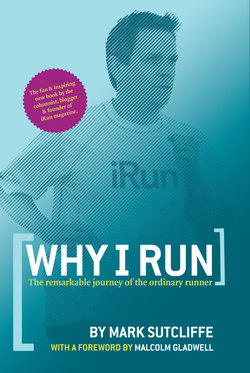Читать книгу Why I Run: The Remarkable Journey of the Ordinary Runner - Mark MDiv Sutcliffe - Страница 14
На сайте Литреса книга снята с продажи.
Faster, harder
ОглавлениеiRun to challenge my perceived limitations Cassandra Williams, Ontario
When I ran my first marathon, I went deliberately slowly. I was less concerned about finishing time than finishing at all. And I knew that if I fed any hint of a time goal to my compulsive, competitive personality, I would risk going too fast.
So I avoided the temptation of aiming for a sub-four-hour finish, trained with a 4:15 pace group and finished in about 4:08.
That gave me an obvious goal for my next marathon, which I planned to do the following spring: to break four hours. But in between, I decided to run a fall half-marathon and use it as a test of whether I had the capacity to go a bit faster.
I’d only run one half-marathon before. Using the same principle of avoiding a time goal, I finished in about 2:03. So for this next test, I figured anything under two hours would be an improvement. I joined the 1:50 pace group at a clinic and started working towards a specific finishing time for the first time in my life.
I figured if I trained for 1:50, I would have a bit of room to spare. Even if things didn’t go well, I could still break two hours.
At this point in my life, one of the things I liked about running was that I wasn’t very good at it. It’s rewarding to find out that you excel at something, and it’s fun and enriching to be a leader and carry some responsibility. But I discovered one of the reasons I liked running, at least at first, was because I didn’t feel any pressure to be the best or run at the front of the pack.
I run my own business. On family trips, I’m usually both the driver and the navigator. I’m a little competitive, so I feel the urge to win whether I’m at work, participating in a recreational sport or even playing board games with kids. I had a pretty good winning streak going in Horse-opoly before my wife pointed out that it might not be healthy for my step-daughter to lose every game.
But in my first marathon clinic, I was happy to fall in behind other more experienced runners during training runs. I was glad to be a follower and not a leader. There’s a lot less pressure in the middle of the pack.
As I was training for this half-marathon in particular, I felt especially happy to fall in line behind other runners. My father’s health was deteriorating, and I found running my only diversion from confronting the fact that he would soon be gone.
So when they asked for volunteers to lead the 1:50 pace group, I started looking at my feet. Unfortunately, the store manager was a friend, and when no one else put up a hand, he singled me out.
I told Jen, the clinic leader, that it felt wrong to be leading a pace group at a speed I had never run before. She reassured me that I would be fine. Besides, there was no one else to do it. I wasn’t even sure I could break two hours in a half-marathon and now I was leading the pace group that was supposed to go ten minutes faster than that.
I have a hard time saying no, so for the next few months, I led a small group of runners on their weekly long run. It went better than I expected. In fact, one day one of them gently complained that we were going too fast. Jen just happened to be nearby so she asked, “Still worried you can’t run fast enough?”
Maybe it was because after slogging through the winter training for a marathon, this time we were training during the summer for a fall event. Maybe it’s because I was a group leader and had no choice but to talk to the other runners. Either way, I discovered that I was enjoying the social aspect of the clinic a lot more. I got to know several of the runners and our runs together became something I looked forward to every week. My life consisted of going to work, visiting my father at his hospice and going for a run.
About ten days before the race, my father died. After the funeral, I decided there was no reason for me not to run the race I’d been training for. My aunt, who travelled from England for the funeral, offered to come out and cheer me on.
I told myself I would be very happy with anything between 1:50 and 1:55 and certainly wouldn’t be disappointed as long as I finished under two hours. But to my surprise, I managed to sustain a steady pace and finished in just over 1:44, much faster than I ever expected. Jen was right to believe I could go faster than I thought I could.
Not surprisingly, I liked the feeling of hitting a time goal and exceeding my expectations. It’s good to aim low to avoid the risk of disappointment. And there’s nothing wrong with trying not to put too much pressure on your running, especially if you’ve got other pressures in life.
But you also shouldn’t avoid the chance to live up to your potential. I’m glad I was pushed into running harder. It gave me the chance to surprise myself and the incentive to try to go even faster in the future.
